Summer Staff Picks
A selection of the books that our staff members have been reading and recommending:
Ashley Nelson Levy, Publisher
On our last trip to New York I picked up Kate Zambreno’s Appendix Project: Talks and Essays, published by semiotext(e). The book is organized into eleven of these essays or talks, written almost as a sequel to her Book of Mutter about the death of her mother, which took Zambreno over a decade to write. More and more I find myself drawn to books with this kind of structure, “constellations of thought,” as Zambreno calls it. Appendix Project calls on the work of Barthes, Sebald, Anne Carson, and others as the author tries to map the first year of her daughter’s life, a sleepless year in which Zambreno again finds herself thinking of her mother, and of the mortality that awakens when becoming a mother herself.
The week I picked up this book I was five months pregnant and had just come down with a flu that I was convinced was listeria, the foodborne illness that all the pregnancy books and baby sites warn you about, leaving you to regard things like hummus and sliced turkey in a cold fear. I sat in bed consumed by grief and anxiety while my son kicked wildly, a morse code that I hoped meant he was safe. I only wanted two things until the fever and vomiting subsided: to talk to my mother and to be told that my child would be okay.
“Grief is an intensity,” Zambreno says, “exhaustion is an intensity, pregnancy is an intensity—it opens something up, some portal, to meditate on time. Writing grief is writing time. It is about how the past invades the present-tense, the day.”
In a conversation with Sarah Manguso in The Paris Review, Zambreno talks about the paralysis that overtook her while under contract to write the new “big” book, and how she began notetaking as a path toward the big book before realizing that the notes were the book itself. Appendix Project is a beautiful exploration of motherhood, of aging, of art and grief, and of loneliness. Also present throughout each of the eleven appendices is Zambreno’s daughter, Leo, who fills the book with a kind of hope for the ways in which time moves us forward.
Adam Levy, Publisher
Isaac Babel is one of the writers I turn to when I find myself in a reading rut. His Red Cavalry Stories are best read in sequence: the voice behind them reveals itself slowly. But drop into any of his Odessa Stories, and you’ll find yourself on a busy street in Odessa—Babel’s early twentieth-century Odessa, which is to say poor, Jewish Odessa—full of gangsters and violence, peering in at kitchens where “a meaty flame, a plump, drunken flame, gushed through their sooty doors” and “the aged faces, wobbly jowls and grimy breasts of housewives baked in its smoky rays.”
I brought four books with me on a recent weekend trip to Los Angeles, optimistically thinking I would get through one. I somehow ended up with another book, a fifth, a new translation of Babel’s Odessa Stories (Pushkin Press), translated by Boris Dralyuk, and read that one instead. Dralyuk was born in Odessa but grew up in Los Angeles, and you can’t read the dialogue in the book’s opening section, “Gangsters and Other ‘Old Odessans,’” without hearing in its cadences a hint of California noir. But the greater charm of the collection lies in the sensitivity and youthful wonder that Dralyuk captures in the stories from “Childhood and Youth,” where innocence is cast against a growing awareness of a harsh political reality and an ambivalent sense of Jewishness. These are the frequently anthologized stories, which include “The Story of My Dovecoat” and “Di Grasso,” in which an Italian actor makes his famous leap across the stage, “asserting with his every word, his every movement, that there was more justice and hope in the frenzy of noble passion than in the world’s joyless rules.” Babel’s prose has a similar kind of effect, and Dralyuk’s new translation reminds us why.
Liza St. James, Editor-at-Large
Lately I’ve been housesitting or commuting distances that feel lengthier in the summer heat, which has required extra decisions about what books to carry. My perpetual nightstand reading stack has, by necessity, grown more portable, more flexible, to provide various options at any given moment. Today, I’ve been enjoying Caren Beilin’s Spain (Rescue Press), a slim and disarming book composed of short, titled sections. Its patterning and distinctive mood make it easy to feel immersed, switch trains, and return to it. I’ve been drawn to Beilin’s sentences since I encountered her novel The University of Pennsylvania, and here they are perhaps even more alluring in conjunction with the slant section titles and constellatory concerns of this woman biding her time in Spain.
Other books I’ve traveled with recently include those that seem designed for opening only once before closing again. Currently these are my favorites, because, like an event, the experience of reading—the day, the light, the sounds that make their way in—feels as significant as the book. A friend read Renee Gladman’s detective story Morelia (Solid Objects), a mystery about language itself, on the couch next to me, and then I read it after her, in the same room. As in a dream, we read the same words—“Grun, grun, gern,” for instance—and likely experienced them differently. Gladman’s note at the end felt providential: “I wrote this story over ten years ago at the end of a strange trip, where a rat crawled on my back in my sleep, where I would always be between places.”
I was at a counter watching a summer storm through a giant glass window while reading The Dry Heart by Natalia Ginzburg, translated by Frances Frenaye (New Directions), when a friend walked into the restaurant and said, “Oh! I had such crazy dreams about that hotel.” She left and the sky was still dark and when I got to the hotel, I was so invested in the narrator’s San Remo getaway that it wasn’t until after it was all over that I remembered my friend’s comment. That night I called another friend, one who’d been there for my early heartbreaks and had shared hers with me too, and I told her I’d be sending her a copy.
Alia DeBurro, Intern
(What kind of an intern would I be if I didn’t choose a Transit book as my summer reading choice?)
Light’s central function is illumination. Naturally, it streams through our windows in the morning and shifts colors as the day progresses. Artificially, it brightens our living rooms, it dims our kitchens, it highlights darkened spots in the basement and the attic. David Hayden, with a voice that can be as majestic as easily as it can be disorienting, is like a bystander to a car crash wearing a headlamp; with a combination of unease and solace, his light illuminates what we consider familiar. His mind may turn to a crevice in the forest (or perhaps a cocktail party with a corpse as the central attraction) and that is where darkness will be exposed. Simultaneously Hayden plays on human emotions, reminding us that “insistent desire and the nearness of death encouraged us to betray our friends, our lovers, our lovers’ lovers.”
Darker With the Lights On, at times, stands us atop a jagged rock and prods us toward the darkness alongside characters in these short stories, only to resurface in an entirely different environment. For example, “Leckerdam of the Golden Hand” is a story narrated in first-person by a father who has been killed by his children. Though the language can be violent or grotesque (sometimes it is both), Hayden weaves a certain type of humanity throughout the story, ending with the idea that though children may inherit a parent’s destructive characteristic, they may eventually become freed from it. In stories that touch on childhood, fatherhood, and the transitory space one inhabits in between, Hayden’s prose is subtly jarring, turning unidentifiable food into a “glistening vermicular heap of noodles,” and a dirty ocean into “ragged ribbons of deep green seaweed bordering the natural pool.” His intermittent humor, more covert in some stories, is the most comforting aspect of his work; it pulls us out of the depths Hayden has taken us to, and at other times, we laugh in the darkness alongside him.
Hayden keeps things wonderfully weird, and each story is a new type of treat.





